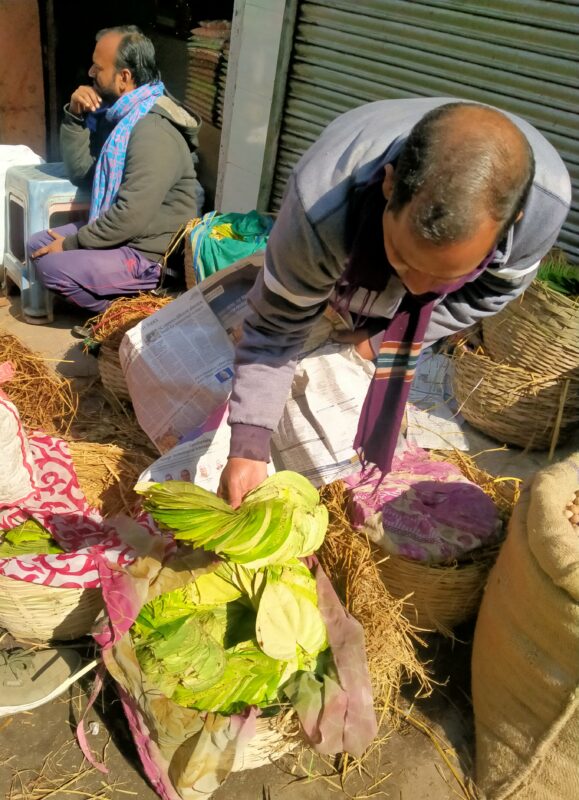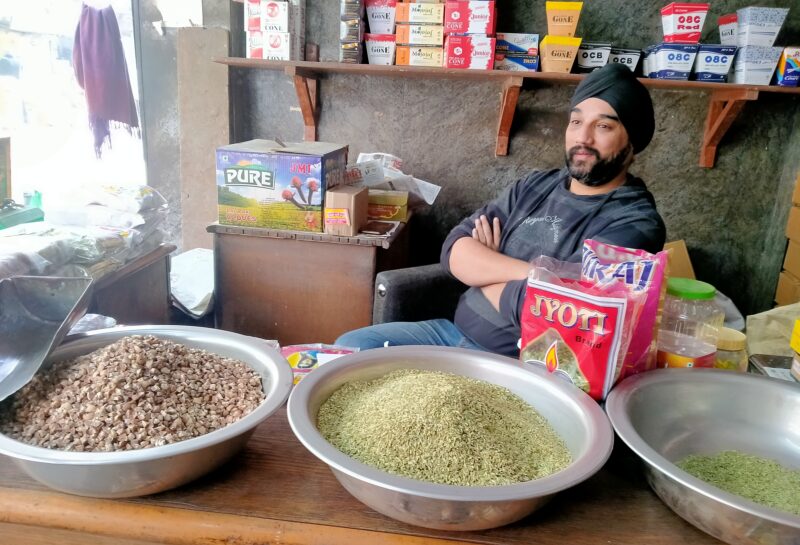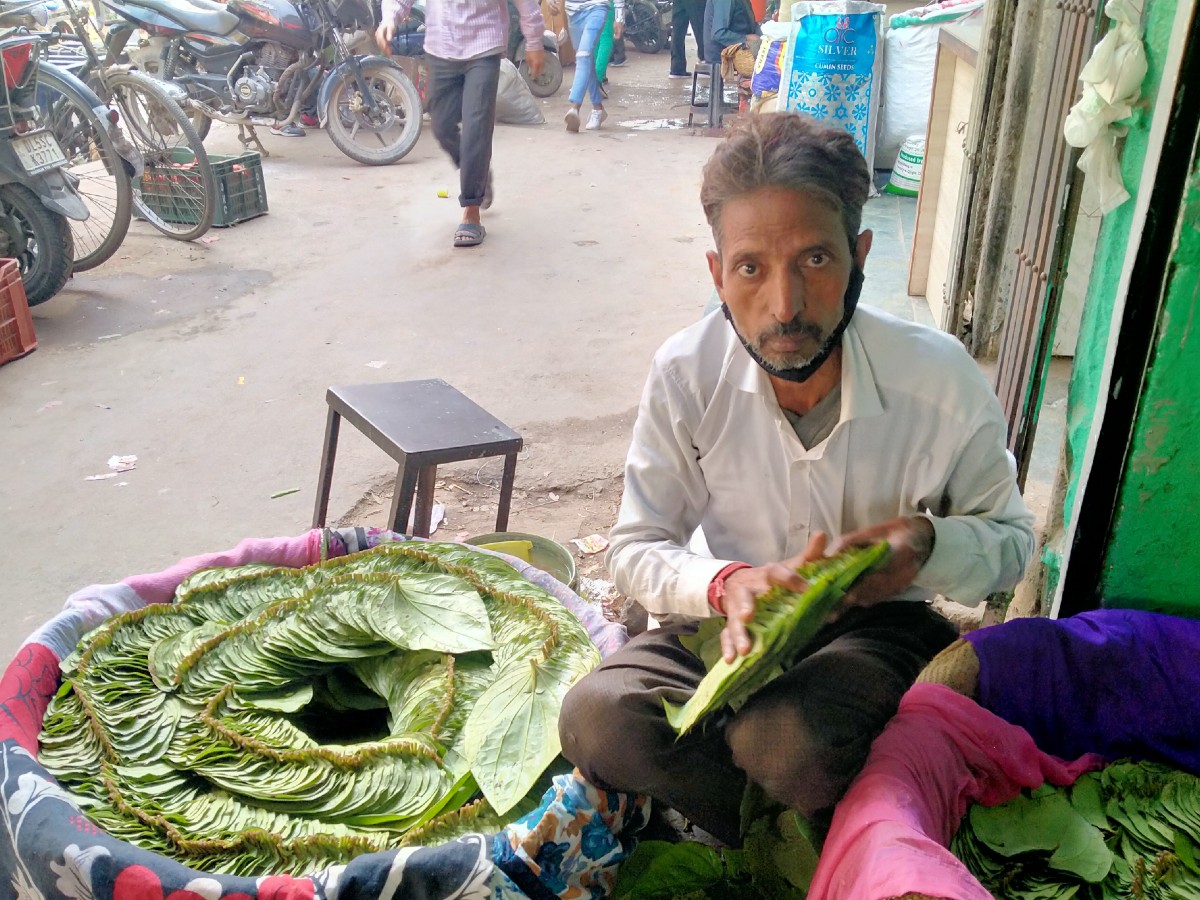Raj Kumar, 55, is sitting on the pavements of Naya Bans Mandi behind Fatehpuri Masjid in the Walled City, which supplies betel leaf to the entire Capital. He has been trading in paan leaves for more than seventy years now. His father also used to sit at the same spot until he decided to retire. Kumar says, “The footfall has reduced drastically over the past five years or so especially. People consume tobacco (gutka) now as it is comparatively cheaper. There’s not much work as is evident from the desolate market.
“Bas gaadi chal rahi hai (We are just surviving)”.
Naya Bans Mandi is not just a wholesale market for paan leaves but also a hub of spices, tea and matchboxes. It lies at a distance of just 50 metres from Fatehpuri Masjid and a few steps from Khari Baoli.
It is 11am in the morning and there are hardly any buyers. Just traders setting up their shops or unpacking the basket of paan leaves. The bazaar is home to paan traders: some dealing in leaves; others in supaari. Their stores hardly have any banner to recognise and some even don’t have a name. However, these stores are testimony to the changing times.
“We purchase paan from different states including Orissa, Bengal, Rajasthan and Madhya Pradesh. Three times a week, trains chug in carrying cargo from these states. They work on commission basis. One basket (doli) usually contains 1,000 leaves. Safed paan (white betel leaf) costs between Rs 100-200 per doli; meetha paan leaf costs between 2500-3000 per doli; maghai is anywhere between 100-150 per doli. Like any precious commodity, the price fluctuates weekly, depending on the supply,” said Deepak, the pradhan (chief) of Dilli Paan Thok Vikreta Sangh, the bazaar’s association of paan traders.
Till 1998, the Delhi Paan Bazaar, the source of supplying betel leaves to the entire city, received 8,000-10,000 banarasi patta baskets every day, each carrying 1,000 leaves. By 2005, the market received 9,000 baskets only five days a week. The number has decreased further to 8,000 thrice a week since 2008. Today, these numbers don’t matter because the condition of market is itself evident.

Tobacco is the killer
The bazaar’s hustle is more due to traders themselves rather than the customers. “The gutka (smokeless tobacco sold in sachets) has severely affected the sale of paan,” says a trader in his late seventies, who wishes to remain anonymous.
Blaming the packaged tobacco that finds more takers because of its low price and easy availability, the man said: “The paan business has gone down by 60% in the last decade. The bazaar used to commission 10,000 baskets daily. Now, we get half of that, three days a week.”
According to him, the bazaar’s daily turnover is Rs 10 lakh.
Delhi has a long history associated with paan with the aristocrats even laying down norms or etiquettes to eat paan. In many households, the paandan (a box that included assorted items used in preparation of paan) would occupy a place of high regard.
It is also believed that once paan was accepted, the eater had to salute the person who had offered it. The gillori (or stuffed betel leaf) would usually, among the elite, be placed in a silver clasp. The eaterwould remove it before placing the leaf in the mouth and allowing to dissolve. The liquid, that will be released in the mouth due to the mix of katthaa (acacia catechu), choona (lime) and paan, would be spitted carefully in a spittoon made of brass or silver.
But according to paan traders, people are moving to gutka because it doesn’t require elaborate preparation and it doesn’t affect their look like chewing of paan’s ingredients would.
Rising input costs
In March 2011, a cover story in the science and environment magazine Down To Earth had said that “the paan’s royal fall is because of chewing tobacco, especially gutka, and skyrocketing input costs, water scarcity and unpredictable weather, which meant betel gardens are no more lucrative”.
Speaking on the price rise, Gurpreet Singh, owner of a shop dealing in supaari, choona and kattha, explained to Patriot, “At this point supaari (betel nut or areca nut) is about Rs 500 per kg. Similarly, other ingredients used to make a paan are highly expensive. It depends on several factors like farming and then how the government regulates the prices. There’s no big margin, and consequently the profit is less. We will have to sell at high prices in future.”
In 2021, the average price was around ₹530. The price of old white arecanut went up to ₹505 per kg and fresh arecanut to ₹460 a kg. The price trend is just growing and prices are extremely high.
He added further, “Primarily for irrigation, that is discouraging betel farmers.”
Gurpreet comes from a farming family.

He shares insights, “Farmers say the cost involved in watering has become a major hurdle in betel farming lately. Earlier, water was not something to worry about as it was available [all] year round.”
The article in Down to Earth mentioned above quoted a farmer as saying, “With rainfall becoming increasingly erratic, ponds do not hold sufficient water all year round.” Betel is vulnerable to even the slightest weather change.
The article further quoted an owner of Subarnarekha, an agri-marketing company in Balasore as saying, “Paan cannot be harvested if temperature goes beyond 40 degree Celsius. 15 years ago, the maximum temperature in Odisha would be 35 degree Celsius. But last year, it touched 42 degree C. Betel leaves turned yellow and dropped prematurely.”
The magazine also quoted him as saying that since the rainfall was no longer uniformly distributed, there could be water-logging and it could perish the garden in four-five days.
The paanwalas in the capital
Prince Paan corner, Delhi’s iconic paan shop prides in making the best paan with their masterful skill.
Yash Tekwani, owner of the shop elaborates, “Making paans is not everyone’s cup of tea. It requires experience. It is not just about putting ingredients in the leaf and folding out.”
On a wall of Prince Paan Corner is a framed collage of Tekwani’s pictures with celebrities, including Bollywood stars. In the pictures, Tekwani is seen posing with Sridevi, Akshay Kumar, Shah Rukh Khan and Lata Mangeshkar.
He owns a fleet of cars and lives in a house in the upmarket Greater Kailash. He claims to have catered to “all of Delhi’s top business families”.
“They order paan from us regularly,” says Tekwani as he reels out names of big businessmen.
“The raw material in the paan is expensive and that’s exactly the reason why our business is cold. Gutka as everyone will agree has slowly killed paan. The young generation is more likely to indulge in flavour paan like chocolate paan and the amount of people eating the simple paan are few. At our shop, the paan does not colour your lips red and create spit in your mouth, which is what makes paan-chewing a bad habit in the eyes of many. A paan is about fragrance and a feeling of freshness, not colouring your lips. The quality of a paan depends on the quality of leaves you choose, and more importantly how you prepare your ingredients,” says Tekwani, standing behind a counter with stacks of a variety of paan leaves, kathhaa and choona in containers.
Prince Paan corner sells wide variety of paans that costs between Rs. 50 to Rs 200/- and people across the age group visit the shop.





